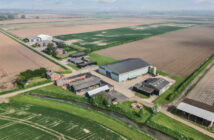One young, award-winning agronomist has proven the efficacy of cultural controls in high-slug pressure situations, following a season-long, field scale trial on her family’s 350-acre farm.
The trial work, led by Sally Morris, Leicestershire agronomist at Hutchinsons, compared the effects of different cultivation techniques on slug populations in drilled winter wheat, following oilseed rape, and commenced directly after harvest in early August.
The results showed that ploughing, followed by drilling and rolling kept slug populations under control, while no-till resulted in a slug pressure that was 29 times higher in comparison.
“Following the success of my previous trials into slug control, demonstrating the efficacy of ferric phosphate, I focused my latest trial in a 15-acre field where we’d previously experienced up to 50% crop losses during establishment, as a result of this troublesome pest.
“The trials concentrated on a range of cultivation techniques and measured the resultant slug pressure. We compared a no-till area, which was direct drilled with one section rolled twice; a min-till area which was lightly disked and then drilled and rolled twice; and a ploughed area, which was broken down with a press and then drilled and rolled twice,” she explains.
“Overall, as expected, the ploughed area was the most effective for slug control, with only two slugs found during monitoring. No pre-baiting was required, and we only needed one application of ferric phosphate at drilling.
“In the no-till area, which hadn’t been rolled, the slug pressure was huge, leading us to conclude that ploughing, and min-till are the best methods for controlling slugs. Particularly on farms with heavy, clay like soils, which are typically challenging.
“The trial work has already been incredibly useful in demonstrating the benefits of different systems and products in practical real field trials, and I’m looking forward to seeing what else we can find.
“It’s these kinds of results that translate into improved crop establishment for farmer, which directly impact the overall productivity of the cropping.”



